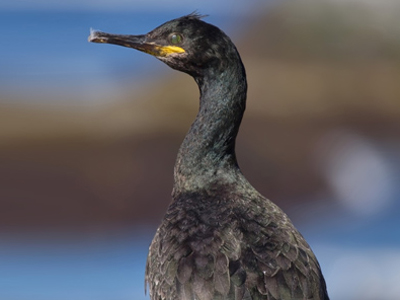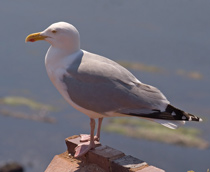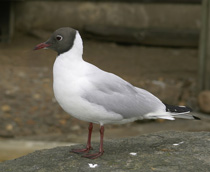
Ask the AI Tutor
Need help with British Birds - Cormorants and Gulls? Ask our AI Tutor!
AI Tutor - Lucy
Connecting with Tutor...
Please wait while we establish connection

They find their prey on the sea bottom. Do you know what bird it is?
British Birds - Cormorants and Gulls
Cormorants are coastal rather than oceanic birds, and some have colonised inland waters - indeed, the original ancestor of cormorants seems to have been a fresh-water bird, judging from the habitat of the most ancient lineage. As for gulls, wherever there are fish and chips, you'll find the gulls! See if you can identify the following birds.
To see a larger image, click on the picture.
1 .
What is the name of this bird?
European Shag
Mediterranean Gull
Lesser Black-backed Gull
Black-headed Gull
- Group: Gulls
- Binomial: Larus fuscus
- Order: Charadriiformes
- Family: Laridae
- Status: Resident Breeding Species And Passage Migrant
- World population is found entirely in Europe.
- Increasingly common in urban habitats, even in inland locations such as the West Midlands.
2 .
What is the name of this bird?
Great Cormorant
Common Gull
Little Gull
Great Black-backed Gull
- Group: Gulls
- Binomial: Larus canus
- Order: Charadriiformes
- Family: Laridae
- Status: Resident Breeding Species, Winter Visitor & Passage Migrant
- Now seen more often in towns and on housing estates in winter.
- An old historical name is sea mew.
- Global population is estimated to be about one million pairs.
3 .
What is the name of this bird?
European Herring Gull
Black-headed Gull
Lesser Black-backed Gull
European Shag
- Group: Gulls
- Binomial: Larus argentatus
- Order: Charadriiformes
- Family: Laridae
- Status: Resident Breeding Species
- The most abundant and best known of its kind along the shores of western Europe.
- Also abundant around inland garbage dumps, and some have even adapted to life in inland cities.
4 .
What is the name of this bird?
Great Black-backed Gull
Common Gull
Great Cormorant
Mediterranean Gull
- Group: Cormorants
- Binomial: Phalacrocorax carbo
- Order: Pelecaniformes
- Family: Phalacrocoracidae
- Status: Resident Breeding Species
- Feeds on the sea, in estuaries, and on freshwater lakes and rivers.
- Breeds mainly on coasts, nesting on cliffs or in trees.
- Dive times of 20–30 seconds are common.
5 .
What is the name of this bird?
Common Gull
Little Gull
Great Black-backed Gull
Black-legged Kittiwake
- Group: Gulls
- Binomial: Larus marinus
- Order: Charadriiformes
- Family: Laridae
- Status: Resident Breeding Species And Passage Migrant
- The largest of its kind in the world.
- The call is a deep 'laughing' cry.
- Opportunistic and get most of their food from scavenging.
- Maximum recorded age is 27 years.
6 .
What is the name of this bird?
European Herring Gull
Common Gull
Little Gull
European Shag
- Group: Cormorants
- Binomial: Phalacrocorax aristotelis
- Order: Pelecaniformes
- Family: Phalacrocoracidae
- Status: Resident Breeding Species
- They find their prey on the sea bottom.
- Will eat a wide range of fish but their commonest prey is the sand eel.
- When they dive, they jump out of the water first to give extra impetus to the dive.
7 .
What is the name of this bird?
Great Cormorant
Great Black-backed Gull
Black-headed Gull
Common Gull
- Group: Gulls
- Binomial: Larus ridibundus
- Order: Charadriiformes
- Family: Laridae
- Status: Resident Breeding Species
- Sociable, quarrelsome, noisy birds, usually seen in small groups or flocks.
- The eggs are considered a delicacy and eaten hard boiled.
- The character 'Kehaar' in Watership Down is this bird.
8 .
What is the name of this bird?
Little Gull
European Herring Gull
Great Cormorant
Black-legged Kittiwake
- Group: Gulls
- Binomial: Larus minutus
- Order: Charadriiformes
- Family: Laridae
- Status: Winter Visitor
- Small and dainty.
- Picks food off the water surface, and will also catch insects in the air.
- Adults in summer have black heads, while young birds have a black mark on each wing which forms a 'W' pattern.
9 .
What is the name of this bird?
Black-headed Gull
Little Gull
Black-legged Kittiwake
Mediterranean Gull
- Group: Gulls
- Binomial: Rissa tridactyla
- Order: Charadriiformes
- Family: Laridae
- Status: Breeding Summer Visitor And Resident Species
- Breeds in large colonies on cliffs and is very noisy on the breeding ground.
- Is capable of utilizing the very sheerest of vertical cliffs.
- They do not scavenge at tips.
10 .
What is the name of this bird?
Little Gull
Mediterranean Gull
Black-headed Gull
Common Gull
- Group: Gulls
- Binomial: Larus melanocephalus
- Order: Charadriiformes
- Family: Laridae
- Status: Breeding Summer Visitor
- Has colonised Britain, mainly in southern and eastern England.
- In winter, migrates to Mediterranean and Atlantic coasts.
- A noisy species, especially at colonies, with a nasal 'yeah' call.
**Unlimited Quizzes Await You! 🚀**
Hey there, quiz champ! 🌟 You've already tackled today's free questions.
Ready for more?
Ready for more?
🔓 Unlock UNLIMITED Quizzes and challenge yourself every day. But that's
not all...
not all...
🔥 As a Subscriber you can join our thrilling "Daily Streak" against other
quizzers. Try to win a coveted spot on our Hall of Fame Page.
quizzers. Try to win a coveted spot on our Hall of Fame Page.
Don't miss out! Join us now and keep the fun rolling. 🎉
**Unlimited Quizzes Await You! 🚀**
Hey there, quiz champ! 🌟 You've already tackled today's free questions. Ready for more?
🔓 Unlock UNLIMITED Quizzes and challenge yourself every day. But that's not all...
🔥 As a Subscriber you can join our thrilling "Daily Streak" against other quizzers. Try to win a coveted spot on our Hall of Fame Page.
Don't miss out! Join us now and keep the fun rolling. 🎉
















